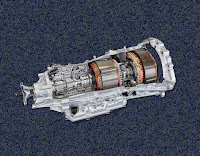Synchromesh Transmission System: An Overview If you're a car enthusiast or a mechanic, you might have heard of a synchromesh transmission system. This type of transmission is commonly used in manual transmissions to make gear shifting smoother and easier....
Synchromesh Transmission System: An Overview
If you're a car enthusiast or a mechanic, you might have heard of a synchromesh transmission system. This type of transmission is commonly used in manual transmissions to make gear shifting smoother and easier. In this guide, we'll explore what a synchromesh transmission system is, how it works, and its benefits and drawbacks. We'll also provide some tips on how to maintain a synchromesh transmission system.
What Is a Synchromesh Transmission System?
A synchromesh transmission system is a type of manual transmission that uses a synchronizer mechanism to match the speed of the input and output shafts before engaging a gear. The synchronizer mechanism is also known as a synchromesh or syncro, hence the name synchromesh transmission system. It was invented by Earl A. Thompson in 1928 and has been widely used in manual transmissions ever since.
A synchromesh gearbox consists of a series of gears that can be engaged or disengaged to transfer power from the engine to the wheels. Each gear has a corresponding synchronizer ring that matches the speed of the input and output shafts before the gear engages. This makes gear shifting smoother and reduces wear on the gears.
How Does a Synchromesh Transmission System Work?
A synchromesh transmission system is a type of manual transmission that uses synchronizer rings to match the speed of the gears before they engage, making for a smooth and seamless gear change. Here's a step-by-step breakdown of how it works:
The synchronizer rings in a synchromesh transmission are made of brass or other soft metals, and they have a cone-shaped profile that allows them to gradually match the speed of the selected gear. The synchromesh system works by using friction between the synchromesh ring and the gear to slow down the gear's rotation until it matches the speed of the output shaft.
The synchromesh transmission system is designed to provide smooth and effortless gear changes, which makes it a popular choice for many drivers. However, it requires a certain level of skill to use effectively, as drivers need to be able to match the engine speed with the speed of the selected gear to avoid grinding or damaging the transmission.
Advantages of Synchromesh Transmission System
There are several advantages to using a synchromesh transmission system, including:
Disadvantages of Synchromesh Transmission System
While synchromesh transmission systems offer several advantages, there are also some disadvantages to consider. These include:
Maintenance Tips for Synchromesh Transmission System
Maintaining a synchromesh transmission system is essential to ensure its longevity and optimal performance. Here are some tips for maintaining your synchromesh transmission:
Check the fluid level regularly: The transmission fluid is crucial for keeping the gears lubricated and cool, which helps prevent wear and tear. Check the fluid level regularly and top up if necessary. Make sure to use the recommended type of fluid for your vehicle. Change the fluid at regular intervals: Over time, the transmission fluid can become contaminated with debris and worn-out particles. To prevent this, it's important to change the fluid at the recommended intervals. Check your vehicle's owner's manual for the recommended schedule. Check for leaks: Transmission fluid leaks can cause damage to the transmission and reduce its effectiveness. Check for leaks under the vehicle and get them repaired promptly if you find any. Use the correct gear oil: It's important to use the correct type of gear oil for your transmission. Using the wrong oil can cause damage to the gears and synchros. Avoid slipping the clutch: Riding the clutch or slipping it excessively can cause unnecessary wear and tear on the synchromesh system. Try to avoid this by engaging the clutch fully when shifting gears. Avoid aggressive shifting: Shifting gears too aggressively can also cause unnecessary wear and tear on the synchros. Try to shift gears smoothly and gradually, matching the engine speed with the speed of the selected gear. Get regular maintenance checks: Have your transmission checked by a professional mechanic at regular intervals. They can inspect the system for wear and tear and recommend any necessary repairs or replacements.
By following these maintenance tips, you can help ensure that your synchromesh transmission system continues to perform optimally and lasts for as long as possible.
The synchromesh transmission system is a tried-and-true technology that has been in use for many years. While it may not be as advanced as some of the newer transmission technologies, it remains a popular choice for many drivers due to its reliability, ease of use, and smooth shifting capabilities. Whether you are looking for a new car or are simply interested in learning more about different types of transmission systems, the synchromesh transmission is certainly worth considering.













